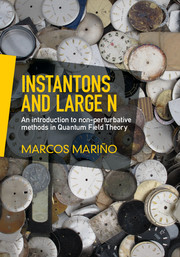Book contents
- Frontmatter
- Contents
- Preface
- Part I Instantons
- Part II Large N
- 6 Sigma models at large N
- 7 The 1/N expansion in Quantum Chromodynamics
- 8 Matrix models and matrix Quantum Mechanics at large N
- 9 Large N Quantum Chromodynamics in two dimensions
- 10 Instantons at large N
- Appendix A Harmonic analysis on S3
- Appendix B Heat kernel and zeta functions
- Appendix C Effective action for large N sigma models
- References
- Author Index
- Subject Index
10 - Instantons at large N
from Part II - Large N
Published online by Cambridge University Press: 05 September 2015
- Frontmatter
- Contents
- Preface
- Part I Instantons
- Part II Large N
- 6 Sigma models at large N
- 7 The 1/N expansion in Quantum Chromodynamics
- 8 Matrix models and matrix Quantum Mechanics at large N
- 9 Large N Quantum Chromodynamics in two dimensions
- 10 Instantons at large N
- Appendix A Harmonic analysis on S3
- Appendix B Heat kernel and zeta functions
- Appendix C Effective action for large N sigma models
- References
- Author Index
- Subject Index
Summary
Introduction
In this final chapter we will analyze the interplay between instantons and the large Nexpansion. As we will see, in the same way that the “classical” large Napproximation involves a non-trivial resummation of perturbation theory, an instanton configuration at large Nis much more complicated that its standard semiclassical counterpart. In some cases, they involve a resummation of Feynman diagrams in the background of a conventional instanton. However, large Ninstantons play an important conceptual role. As we have seen in Chapter 3, in theories without renormalons, instantons can be “discovered” by looking at the large order behavior of the perturbative expansion. One might suspect that a similar phenomenon would occur for the 1/N expansion, and indeed, in many examples, large Ninstantons are connected to the large order behavior of the 1/N expansion.
In this chapter, we will first discuss some general properties of the 1/N expansion and large Ninstantons. We will then show that, in some of the toy models considered in this book, such as matrix models and ℂℙN−1 models, large Ninstantons can be analyzed in detail.
Analyticity and the expansion
As we discussed in Chapter 3, standard perturbation theory (even in the absence of renormalons) is divergent due to the factorial growth of the number of Feynman diagrams. In the 1/N expansion, however, we have to consider fatgraphs with a fixed topology. For example, each genus gfree energy (7.3.3) is given by a sum of fatgraphs of genus g. It is therefore interesting to know how the number of such fatgraphs grows with the number of loops, since this will determine to a large extent the growth of the coefficients ag,hin (7.3.3), as hgrows large.
It turns out that the number of planar diagrams (and, more generally, the number of fatgraphs with a fixed genus) grows only exponentiallywith the number of loops. This is much slower growth than the factorial growth of usual Feynman diagrams. Such a phenomenon can already be observed when we compare the number of graphs in the standard quartic oscillator and the number of planar graphs for the matrix quartic oscillator of Section 8.4: if we look at the numbers involved in Table 1.1 and at the numbers involved in Table 8.1, we see that, by restricting ourselves to planar diagrams, the symmetry factors are drastically reduced.
- Type
- Chapter
- Information
- Instantons and Large NAn Introduction to Non-Perturbative Methods in Quantum Field Theory, pp. 301 - 326Publisher: Cambridge University PressPrint publication year: 2015

